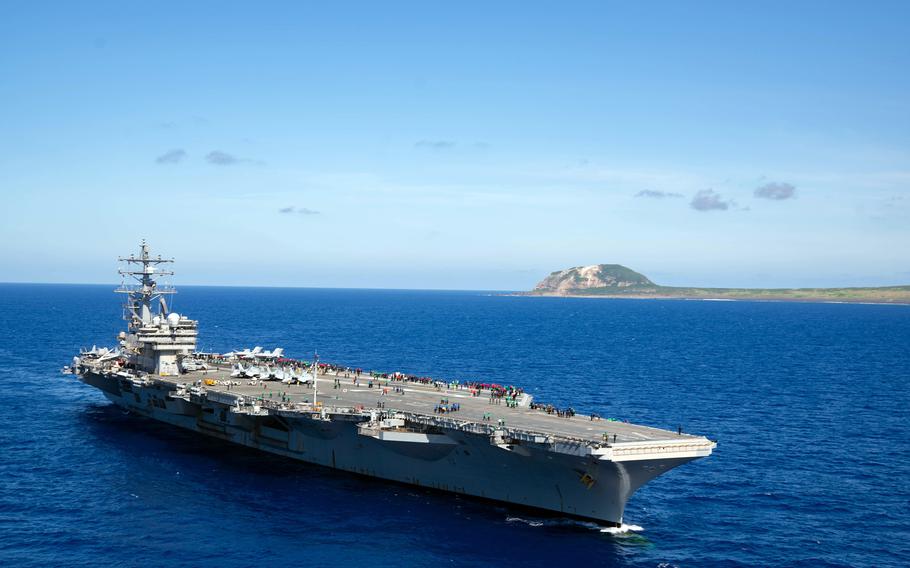
The aircraft carrier USS Ronald Reagan sails near Iwo Jima, known in Japan as Iwo To, in the Philippine Sea, May 22, 2021. (Jason Tarleton/U.S. Navy)
The Navy is expected to send its only Indo-Pacific-based aircraft carrier to the Middle East this summer to support the planned withdrawal of U.S. troops from Afghanistan, multiple media outlets reported Wednesday.
President Joe Biden earlier this year set a deadline of Sept. 11 – the 20th anniversary of the terrorist attacks on the World Trade Center and Pentagon that set in motion U.S. military action in Afghanistan – for bringing home the remaining troops from the war-torn country.
The Japan-based USS Ronald Reagan will relieve the USS Dwight D. Eisenhower and its strike group in the North Arabian Sea, according to the Wall Street Journal, which first reported the planned deployment and cited unnamed defense officials. The Eisenhower is slated to return to its Norfolk, Va., homeport in July. The carrier has deployed twice in the past 36 months and can’t safely extend beyond summer, the officials told the newspaper.
The Ronald Reagan is expected to operate in the Middle East for up to four months, according to the report. The Navy will go without an aircraft carrier in the Indo-Pacific for at least part of that time, the officials said.
Pacific Fleet referred a Stars and Stripes query on the move to the Pentagon.
“We don't talk about potential ship movements in advance,” Pentagon press secretary John Kirby told reporters during a news conference Wednesday when asked about the Ronald Reagan.
The carrier is permanently deployed at Yokosuka Naval Base and normally spends about half the year at sea patrolling the Indo-Pacific. The ship left Yokosuka on patrol May 19.
USNI News reported Wednesday that it had confirmed the Ronald Reagan’s upcoming deployment with two unnamed defense officials.
The last time a Yokosuka-based carrier deployed to the Middle East was in 2003 when the USS Kitty Hawk supported the U.S. invasion of Iraq, according to the report.
Meanwhile, the carrier USS Theodore Roosevelt returned to its homeport in San Diego on Tuesday after completing a five-month deployment that included the Gulf of Alaska and the contested South China Sea.
While the 7th Fleet has roughly 50 to 70 ships and submarines, the Ronald Reagan and its strike force are the Navy’s most visible projection of maritime power in the Indo-Pacific.
The Navy has used the carrier and other warships to push back on China’s aggressive claims of sovereignty over most of the South China Sea.
In February, the carriers USS Nimitz and USS Theodore Roosevelt moved to the Indo-Pacific to exercise together in the South China Sea while the Ronald Reagan was in port for regular maintenance.
On Saturday, the Royal Navy carrier HMS Queen Elizabeth, with 10 U.S. Marine Corps F-35B Lightning II stealth fighters aboard and its strike group alongside, left the United Kingdom, bound for an Indo-Pacific patrol with stops in Japan, India, South Korea and Singapore, according to The Associated Press.
Ships of the 7th Fleet routinely transit the Taiwan Strait, another hotspot where Chinese military aircraft have been flying into Taiwan’s air defense zone.
Twitter: @WyattWOlson